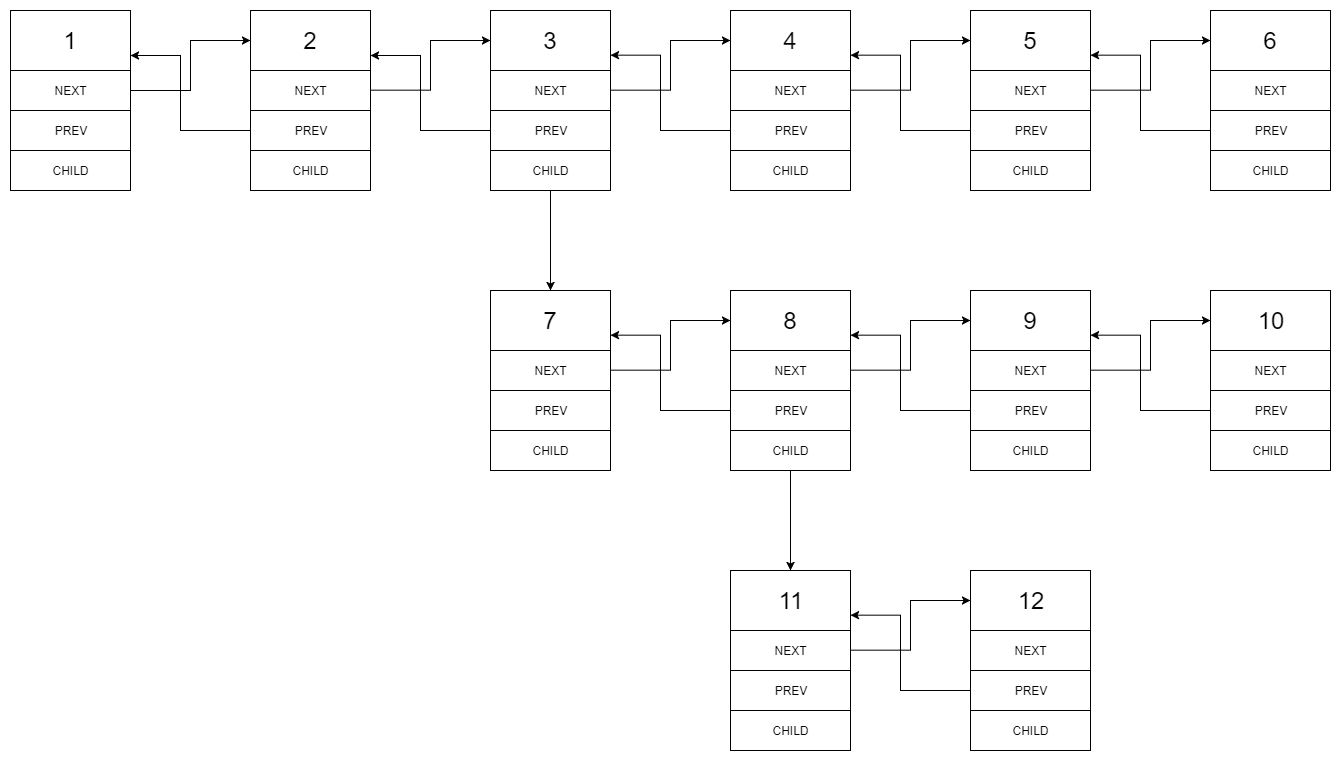题目描述
You are given a doubly linked list which in addition to the next and previous pointers, it could have a child pointer, which may or may not point to a separate doubly linked list. These child lists may have one or more children of their own, and so on, to produce a multilevel data structure, as shown in the example below.
Flatten the list so that all the nodes appear in a single-level, doubly linked list. You are given the head of the first level of the list.
样例
Input:
1---2---3---4---5---6--NULL
|
7---8---9---10--NULL
|
11--12--NULL
Output:
1-2-3-7-8-11-12-9-10-4-5-6-NULL
Explanation for the above example:
Given the following multilevel doubly linked list:

We should return the following flattened doubly linked list:

题意:给一个带有孩子节点的多层双向链表,希望将这个链表扁平化变成一个单层的双向链表。
算法1
(递归解法)
题解:类似于树一样的结构,使得我们考虑用递归处理这样的问题。对于每一个节点总共有四种情况,只有后驱节点;只有孩子节点;即没有孩子节点也没有后驱节点;有后驱节点和孩子节点。其实本质上这一题也是个链表插入的问题。
当我们遇到一个有孩子节点的节点时,如果我们有一个函数能获得该孩子节点的扁平化后的末尾节点(如遍历到3号节点时,如果我们已经将其孩子链表变成了7-8-11-12-9-10,而且我们得到了末尾10号节点),那么我们只需要将7-8-11-12-9-10这一段链表插入到3-4之间就可以得到答案了。
C++ 代码
Node* flatten(Node* head) {
Node *p = flat(head);
return head;
}
Node* flat(Node* head)
{
while(head)
{
//既没有孩子节点也没有后驱节点,说明已经是该层最后一个节点了,如6,10,12。
if(!head->next && !head->child)return head;
//如果没有孩子节点,只有后驱节点。如1,2,4,5,7,9,11
if(!head->child)
head = head->next;
//既有孩子节点也有后驱节点
else if(head->next)
{
//先将孩子链表扁平化并返回末尾节点。
Node* tail = flat(head->child);
Node* temp = head->next;
tail->next = temp;
head->next = head->child;
//将扁平化的链表插入当前节点的后面,注意是双向链表,并且孩子节点需要变成NULL
if(tail->next)tail->next->prev = tail;
if(head->next)head->next->prev = head;
head->child = NULL;
//更新当前节点
head = tail->next;
}else
{ //只有孩子节点,没有后驱节点。那么只需要将孩子节点变成后驱节点就可以了
head->next = head->child;
head->next->prev = head;
head->child = NULL;
head = head->next;
}
}
return head;
}

